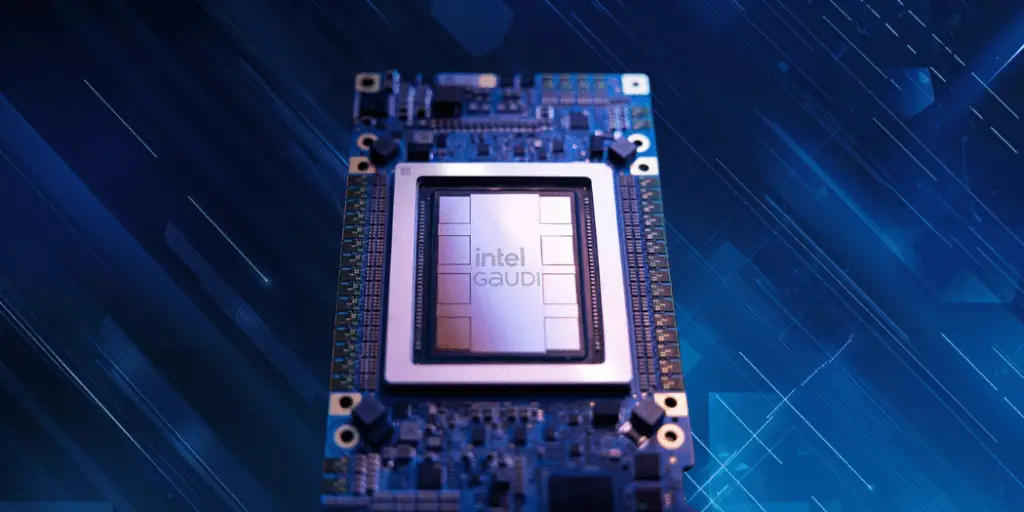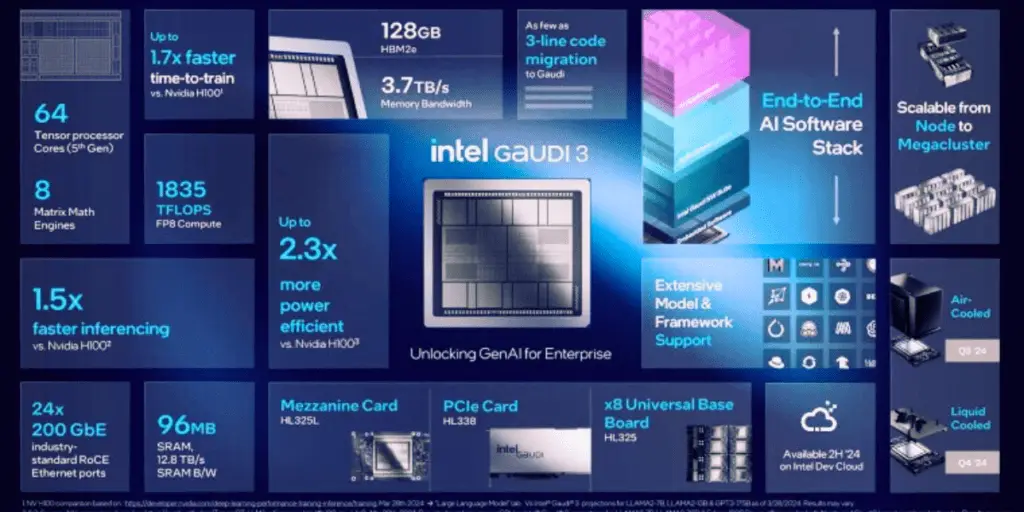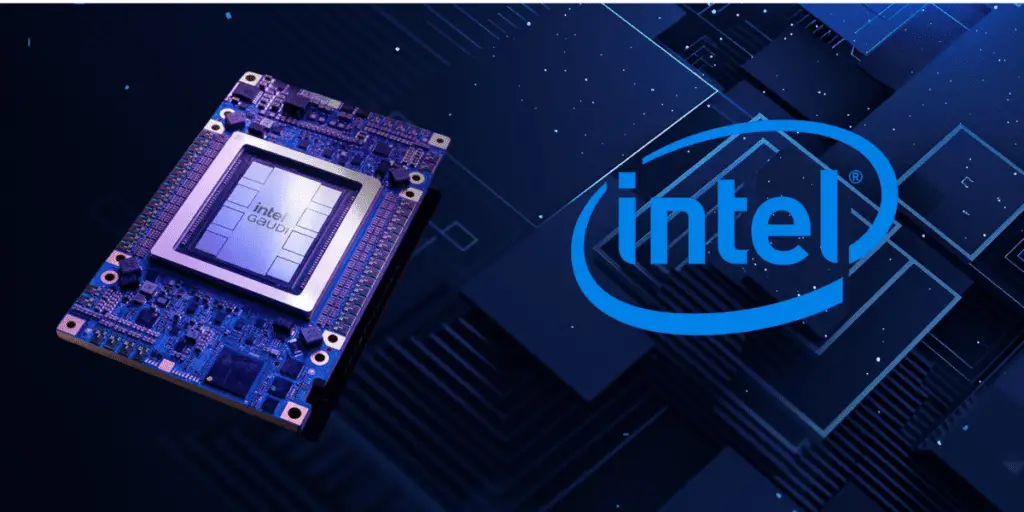Aimed at reshaping the competitive dynamics of the artificial intelligence semiconductor sector, Intel has announced the launch of its Gaudi 3 AI chip.
This development marks a pivotal moment in Intel’s ongoing efforts to erode Nvidia’s stronghold on the AI chip market, where Nvidia has enjoyed an approximate 80% share, mainly due to its high-performance GPUs favoured by AI developers.
The unveiling of the Gaudi 3 chip signifies Intel’s aggressive push into AI, promising advancements in power efficiency and processing speeds that could challenge Nvidia’s dominance.
We will delve into the capabilities and innovations of the Gaudi 3 AI chip, its strategic importance to Intel, and its potential impact on the broader AI and semiconductor industries. We will highlight a burgeoning rivalry that could drive forward the next generation of AI technology.
Intel’s Gaudi 3 AI Chip
Intel’s latest foray into the artificial intelligence market, the Gaudi 3 AI chip, is a significant leap forward in chip technology. It is designed to outperform and out-efficiency its main competitor, Nvidia’s H100 GPU.
The Gaudi 3 stands out for several reasons, chief among them its power efficiency and processing speed, which Intel claims surpasses that of the H100 GPU by over two times in power efficiency and 1.5 times in AI model running speed.
The Gaudi 3 chip has been designed to reduce energy consumption while maintaining high performance, a critical factor for data centres looking to lower operational costs.
Intel asserts that Gaudi 3 can process AI models faster than its predecessors and competitors, promising a significant boost in efficiency for AI tasks.
The chip is available in various configurations, including a bundle of eight Gaudi 3 chips on a single motherboard or a singular card format that can easily integrate into existing systems, offering flexibility for different use cases.
Intel has rigorously tested the Gaudi 3 chip on numerous AI models, including Meta’s open-source Llama and the Abu Dhabi-backed Falcon, showcasing its ability to efficiently train and deploy models like Stable Diffusion and OpenAI’s Whisper model for speech recognition.

This wide range of compatibility highlights Gaudi 3’s potential to cater to diverse AI applications, from language processing to image generation.
Slated for release to customers in the third quarter, the Gaudi 3 chip has already garnered support from significant system manufacturers such as Dell, Hewlett Packard Enterprise, and Supermicro.
These partnerships are poised to facilitate the chip’s integration into the broader market. Intel has yet to disclose specific pricing details.
Intel’s Gaudi 3 AI chip represents a strategic push into the AI chip market, challenging Nvidia’s dominance with a promise of superior power efficiency, speed, and flexibility.
As Intel positions Gaudi 3 as a highly competitive option in the AI technology landscape, the industry watches closely to see how this rivalry unfolds and what it means for the future of AI computing.
Market Context
The unveiling of Intel’s Gaudi 3 AI chip arrives at a critical juncture in the AI chip market, a sector experiencing rapid growth and intense competition.
Currently, Nvidia commands an imposing presence in this space, holding an estimated 80% market share. This is thanks primarily to its suite of GPUs, which have become the go-to choice for AI developers seeking high performance and reliability for their AI and machine learning projects.
Nvidia’s leadership in the AI chip market is a testament to its technological prowess and the comprehensive ecosystem it has built around its GPUs, including software and developer tools.
These GPUs have been instrumental in training complex AI models, making them indispensable for many cutting-edge AI applications.
The demand for AI chips is surging, driven by the escalating needs of data centers, cloud providers, and enterprises to deploy AI applications, from natural language processing to computer vision.
This demand is bolstering the growth of the data centre AI market, creating opportunities for new entrants and innovation in semiconductor technologies.
A significant challenge within the AI space is the high cost of running generative AI models, particularly when it involves purchasing and maintaining high-end GPUs like those offered by Nvidia.
This has prompted companies to seek more cost-effective alternatives, diversify their supply chains, and reduce dependence on a single supplier.
Intel’s Gaudi 3 is part of a broader trend of semiconductor companies venturing into the AI chip market or expanding their offerings. AMD, for example, is enhancing its portfolio with the MI300X data center GPU, already embraced by tech giants like Meta and Microsoft.
Nvidia itself continues to innovate. It has announced its B100 and B200 GPUs as successors to the H100, promising even greater performance gains.
A critical aspect of Nvidia’s success has been its CUDA software, which facilitates deep integration and optimization of AI applications on its GPUs.
Intel’s strategy includes forging partnerships and building open software ecosystems with other tech leaders like Google, Qualcomm, and Arm, aiming to provide a flexible and non-proprietary alternative that could encourage software developers to explore different hardware options.
As Intel introduces the Gaudi 3 chip into this competitive landscape, the company challenges Nvidia’s market dominance and contributes to the dynamic evolution of AI technologies, potentially reshaping market dynamics and fostering a more diversified and innovative ecosystem.
Features and Performance
Intel’s Gaudi 3 AI chip is engineered to set new benchmarks in the artificial intelligence technology sector, emphasizing power efficiency, speed, and versatility. Its introduction is a bold step towards challenging the status quo in the AI chip market, currently dominated by Nvidia.
Intel’s Gaudi 3 chip is designed to be more than twice as power-efficient as its main competitor, Nvidia’s H100 GPU.
This enhancement in power efficiency means that it can perform the same tasks using significantly less energy, a critical factor for data centres focused on reducing operational costs.
The chip is capable of running AI models one-and-a-half times faster than the H100 GPU. This increase in processing speed could dramatically shorten the time required for training and deploying complex AI models, making it a valuable asset for AI research and development.
Gaudi 3 comes in various configurations, including options for bundling eight chips on a single motherboard or a single chip card that can fit into existing systems. This flexibility allows for easy integration and scalability depending on the specific needs of the deployment.
The chip has been rigorously tested with a range of AI models, including Meta’s open-source Llama and the Abu Dhabi-backed Falcon.

Its ability to efficiently train and deploy diverse models, such as Stable Diffusion for image generation and OpenAI’s Whisper for speech recognition, demonstrates its versatility across different AI tasks.
Intel has conducted comprehensive testing to compare the Gaudi 3 chip’s performance against leading competitors. These tests highlight the chip’s strengths in efficiency and speed, particularly in training and deploying cutting-edge AI models.
The chip is well-suited for a wide array of applications, from data analytics and natural language processing to more specialized tasks like autonomous vehicle technology and real-time translation services, showcasing its adaptability to different sectors.
The introduction of the Gaudi 3 chip represents a significant leap forward in Intel’s AI strategy. By offering a chip that not only competes on power efficiency and speed but also provides versatile configurations and broad model compatibility, Intel is positioning itself as a formidable contender in the high-stakes AI chip market.
This move could catalyze further innovation and competition, pushing the boundaries of what’s possible in AI technology.
Competitive Landscape
The introduction of Intel’s Gaudi 3 AI chip comes at a time when the AI chip market is witnessing intense competition and rapid evolution, driven by the increasing demand for high-performance computing in AI applications.
This competitive landscape is not only about the technological supremacy of chipsets but also about shaping the future of AI development and deployment across various industries. Here’s an overview of the current competitive scenario:
Nvidia has established itself as the frontrunner in the AI chip market, primarily through its GPUs, which have become synonymous with AI and machine learning tasks.
Its estimated 80% market share speaks volumes about its dominance and the effectiveness of its products and ecosystem, particularly its CUDA software platform that has facilitated the development of AI applications.
Intel’s Gaudi 3 chip represents a direct challenge to Nvidia’s stronghold, highlighting a strategic shift towards more power-efficient and faster processing AI chips.
Intel aims to differentiate itself with the Gaudi 3’s capabilities, particularly its superior power efficiency and processing speeds compared to Nvidia’s offerings. Intel’s approach also emphasizes flexibility and integration ease, potentially attracting a broader range of customers.
AMD is another significant player seeking to expand its footprint in the AI chip market. With its MI300X data centre GPU, AMD has already started to make inroads, boasting partnerships with major tech companies like Meta and Microsoft.
Nvidia continues to innovate, with the B100 and B200 GPUs set to succeed the H100, promising further performance enhancements and solidifying its competitive position.
The high cost of running AI models, especially with Nvidia’s GPUs, has led many companies to explore alternatives.
This demand for cost-effective, high-performance AI chips opens the door for Intel and AMD to gain market share. It also encourages the development of a more diversified AI chip ecosystem, reducing dependence on a single supplier and fostering competition.
A crucial aspect of this competitive landscape is the development of open software ecosystems. Nvidia’s success has been partly due to its proprietary CUDA platform.
Intel is capitalizing on open software ecosystems, collaborating with giants like Google, Qualcomm, and Arm to offer more flexible and non-proprietary solutions. This strategy could enable easier transitions between chip providers and encourage broader adoption of AI technologies.
Strategy and Collaborations
Intel aims to attract a broad customer base by competitively pricing the Gaudi 3 chip. By doing so, Intel not only challenges Nvidia’s market share but also addresses a critical barrier for many companies: the high cost of AI computing.
This strategy could make AI technologies more accessible to a wider range of businesses and developers.
The Gaudi 3 chip boasts significant improvements in power efficiency and processing speeds compared to its competitors.
Intel emphasizes the chip’s flexible configurations and its ability to integrate into existing systems, making it an attractive option for companies looking to upgrade or expand their AI capabilities without a complete overhaul of their infrastructure.
Building an Open Software Ecosystem: Recognizing the pivotal role of software in maximizing hardware capabilities, Intel is actively working to build an open software ecosystem.
This initiative aims to reduce the industry’s reliance on proprietary systems like Nvidia’s CUDA by offering a more flexible and adaptable framework for AI development.
Intel’s collaboration strategy involves partnering with other technology leaders, including Google, Qualcomm, and Arm, to foster an environment of innovation and integration.
These partnerships are geared towards developing reference software and building blocks that enable seamless solution stitching, as opposed to being locked into a single vendor’s ecosystem.

Beyond just competing with Nvidia in traditional markets, Intel’s strategy with the Gaudi 3 chip also involves exploring new markets and use cases for AI technologies.
By demonstrating the chip’s versatility across various AI models and applications, Intel aims to capture emerging opportunities in fields such as healthcare, autonomous vehicles, and IoT devices.
Intel is not just focusing on technological aspects but also engaging with potential customers early on.
By involving companies like Dell, Hewlett-Packard Enterprise, and Supermicro in the development and deployment process, Intel ensures that the Gaudi 3 chip meets the practical needs and expectations of its end users.
Final Thoughts
The launch of Intel’s Gaudi 3 AI chip marks a pivotal moment in the evolving landscape of the AI semiconductor market.
By introducing a product that promises superior power efficiency, enhanced processing speeds, and versatile configurations, Intel is directly challenging Nvidia’s dominance and signaling a new era of competition and innovation.
This strategic move is not merely about capturing market share but also about pushing the boundaries of what’s possible in AI technology.
Intel’s approach, emphasizing competitive pricing, technological innovation, and strategic collaborations, reflects a deep understanding of the market’s needs and the challenges that lie ahead.
The partnerships with tech giants and the focus on building an open software ecosystem are particularly noteworthy, as they aim to democratize AI development and reduce the industry’s reliance on proprietary solutions.
As we look to the future, the implications of Intel’s entry into the AI chip market with the Gaudi 3 extend far beyond a simple rivalry with Nvidia.
This initiative has the potential to catalyze a wave of innovation, fostering a more diversified and competitive landscape. It could lead to the development of more accessible, efficient, and powerful AI technologies that benefit a wide range of industries and applications.
AI chip market’s evolution will likely spur further collaborations and technological advancements, as companies strive to meet the growing demands for AI and machine learning capabilities.
In this dynamic environment, Intel’s Gaudi 3 chip could play a significant role in shaping the future of AI, encouraging an era where technological advancements are driven by collaboration, competition, and a shared vision of unlocking AI’s full potential.


